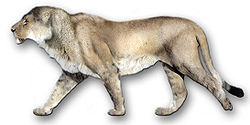American lion
The American lion (Panthera leo or P. atrox) is also known as Naegele’s giant jaguar or American cave lion. It is an extinct species of lion which lived in North America during the Pleistocene (340,000 years ago to 11,000 years ago). It existed for about 330,000 thousand years.[1]
| American lion | |
|---|---|

| |
| Skeleton from the La Brea tar pits at the George C. Page Museum | |
| Scientific classification | |
| Kingdom: | Animalia |
| Phylum: | Chordata |
| Order: | Carnivora |
| Family: | Felidae |
| Genus: | Panthera |
| Species: | †P. atrox
|
| Binomial name | |
| Panthera atrox (Leidy, 1853)
| |

| |
| The maximal range of cave lions - red indicates Panthera spelaea, blue Panthera atrox, and green Panthera leo leo/Panthera leo persica. | |
The American lion belonged to the family Felidae. By analysing the species' genes, scientists have shown that it shared the same ancestor as the Eurasian cave lion (Panthera leo spelaea or P. spelaea).[2] Most remains have come from the La Brea tar pits.
The American lion was large, slightly larger than the early middle Pleistocene cave lion, P. leo fossilis and about 40% larger than the modern African lion.[3] There is no evidence that it was a social hunter like the modern lion, and that may explain its size. Panthera leo atrox hunted large mammals such as horses, camels, bison and mammoth.
American Lion Media
Environment of what is now White Sands National Park, with American lions drinking in the background
References
- ↑ Strauss, Bob 2016 update. "American Lion (Panthera leo atrox)". The New York Times Company. Archived from the original on 2016-09-27. Retrieved 2012-03-10.
- ↑ R. Barnett; et al. (2009). "Phylogeography of lions (Panthera leo ssp.) reveals three distinct taxa and a late Pleistocene reduction in genetic diversity". Molecular Ecology. 18 (8): 1668–1677. doi:10.1111/j.1365-294X.2009.04134.x. PMID 19302360. S2CID 46716748.
- ↑ Deméré, Tom 2009. SDNHM Fossil Field Guide: Panthera atrox


